|
American Muscle Cars of 1968
|
Country: |
 |
|
Plymouth Road Runner
Probably the biggest news on the car scene for
1968 was Plymouth's new
Road Runner. Chrysler never dreamed the car would be such a hit. They took the base-level B-body and loaded it up with a hot 383 and performance goodies — and left out the fluff. When the car was Hemi-equipped, you knew that "Beep-Beep" horn meant business. The Highland Park group had been planning a production run of about 2500 units. But once the cars hit the showrooms, it was all Chrysler could do to keep up with demand. Eventually, some 45,000 cars hit the boulevards of America. Dodge's version was known as the Super Bee, but Chrysler wound up getting stung with this one.
The marketing strategy of using a bumblebee just didn't work, which is not surprising. Chrysler offered an amazing variety of engines, including 170 and 225 sixes, and 273, 318, 340, 383,426 and 440 V8s - a dozen horsepower ratings in total. The new high-performance, small-block 340 was almost a brand-new big-port head castings with larger
valves, big intake manifold with 650 cfm Carter AVS 4-barrel, 10.5:1 compression, hot cam, beefed-up rods and forged crankshaft, windage baffle and streamlined
exhaust manifolds. The ultra-responsive 275-hp 340 could propel the lightweight Barracudas and Darts to mid-14 quarters and deliver 15 to 18 mpg as well.
You could also get a big-block 3 83 in a Barracuda, but the package was so nose heavy that both traction and handling went down the tubes. It wasn't a popular option at all. With the group American Breed singing their hit "Bend Me, Shape Me," Chrysler responded by giving much of its line-up all-new sheet-metal, with the Charger receiving a complete revamp. The 426 Street
Hemi option made it run like the wind. In the hands of a pro like "Dandy" Dick Landy, prepped NHRA-legal 3600-pound Chargers ran high 10s at nearly 130 mph. But the ultimate Chrysler factory hot rod wasn't a Charger. Model No. B029, coupled with the special order code 366, got you an elephant of major proportions - a racing
Hemi in a lightweight Barracuda or Dart body.
The cars were acid-dipped and trimmed with liberal use of fiberglass, the successful diet resulting in a weight of only about 3000 pounds. This factory-produced land rocket could cover a quarter mile in the mid-lOs at about 130 mph. A warranty was not available, and neither was food in Biafra. The 1968
Pontiac GTO offered Ram Air induction, Endura plastic nose and a new body style. Censorship was also tested at Indianapolis, where the
USAC. decided to ban turbine-powered cars after the disputed power-plant almost won the 500. Bobby Unser wound up victorious in an Offy-powered Eagle and went on to win the
USAC driving championship. Graham Hill became World Champion in Formula One, and David Pearson was at the top of NASCAR.
Mercury Cougar GTE
Mercury's Cougar GTE was the last production Ford product to use the 427 Wedge power-plant, rated at a detuned 390 hp with a medium-riser manifold. The package used early 406
cylinder heads and a mild hydraulic cam, while retaining goodies like the forged steel crank and cross-bolted main bearings — hardly necessary with the 5800 rpm rev limit of the hydro lifters. Dual hood scoops and distinctive paint schemes were part of the GTE package. The car is a rare find today. " D y n o " Don Nicholson and "Fast" Eddie Schartman campaigned awesome Cougars on the match race circuit. The fuel-burning Funny Cars ran in the low 7s.
On the NASCAR front, Cale Yarborough won the Daytona 500 in a Mercury Cyclone prepped by the Wood Brothers, and a GT-40 once again took LeMans. Ford went the full route on Fairlanes and Comets with a thorough re-skinning. The new 428
engine was available in these models, as well as in the Mustang Cobra Jets, a midyear intro. Optional on the Mustangs was a ram air-style shaker hood scoop that operated by vacuum. Mustang CJs were very successful in NHRA racing, despite the fact that they carried very conservative 335 hp ratings. They were really much closer to 400 hp. By the time the cars hit the showrooms in April, Ford street fans were breaking down the doors. Mustangs were still ahead of Camaros in Sales, but the gap had narrowed.
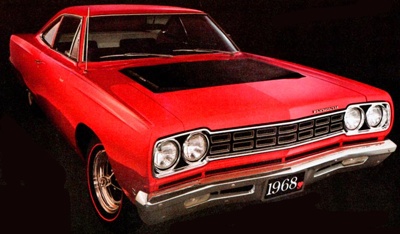
The 1968 Plymouth Road Runner.
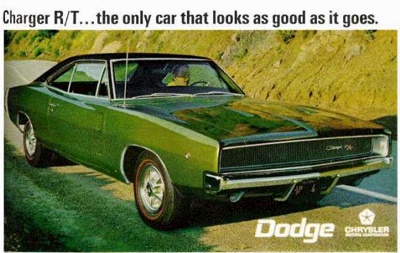 1968 Dodge Charger R/T.
1968 Dodge Charger R/T.
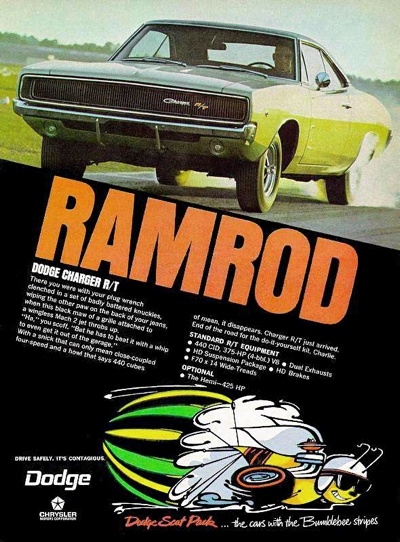 1968 Dodge Charger R/T Ramrod.
1968 Dodge Charger R/T Ramrod.
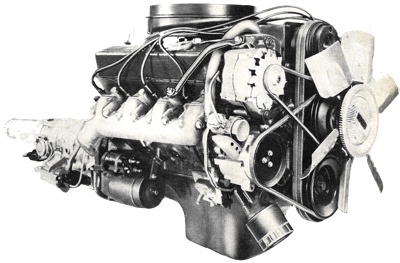 Cadillac's Whopping 427ci "integrated" V8.
Cadillac's Whopping 427ci "integrated" V8.
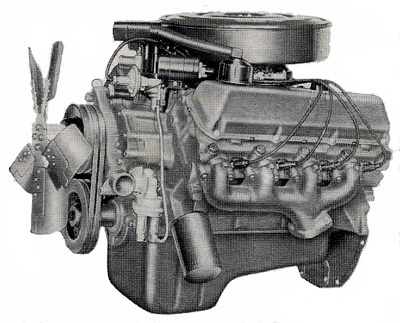 FoMoCo's 1968 429ci V8. Arguably the first mass produced American V8 to prove that meeting California's then new anti-pollution legislation could be achieved without any performance hit.
FoMoCo's 1968 429ci V8. Arguably the first mass produced American V8 to prove that meeting California's then new anti-pollution legislation could be achieved without any performance hit.
|
FoMoCo convertibles lost popularity, as ragtop orders dropped 40 percent from the prior year, with GM and Chrysler experiencing much of the same. Production of
Shelby Mustangs reached a peak, with 4450 rolling off lines in Michigan. Not many people opted for the base GT 350 with the 302-cubic-inch
engine rated at 250 hp. Instead,
Shelby customers went for the gusto in the form of the GT 500, available with either the 427 or 428 engines. But Carroll Shelby's interest was waning, as Ford continued to soften the car's hard-core performance image.
GM changed its intermediate body styling. Pontiac made the most of the revisions by retaining the original character of the GTO while remaining a looker in the process. Pontiac also brought on board the famous Ram Air option. Coupled with a radical cam, special heads and other goodies, the car was a certified goer. New also was an "Endura" flexible front bumper/nose piece, an industry first, complete with hideaway headlamps. Firebirds were virtually a carryover with
engine refinements.
A true musclecar legend was born late in the model year in the form of the Hurst-Olds. The car was powered by a massive 455 Toronado
engine producing 380 hp. Naturally, it featured a Hurst Dual-Gate shifter for the reworked Turbo 400 transmission, and the package included the W30 induction system. The car offered both Oldsmobile and Hurst high visibility among performance car buffs, and just 515 were produced, though there were orders for many more. This near two-ton combination was good for high 13s in absolutely stock form. Set up properly for the quarter mile, a Hurst-Olds would break into the 12s. It became one of the best-known and most seldom seen cars of the decade.
At last,
4-4-2 Oldsmobiles could be had with factory-installed Forced Air packages, eliminating the expense and hassle of the previous dealer installation. The W30 combo featured the famous vacuum cleaner intakes below the bumper. It was a true horsepower bargain, with the cost a paltry $263. Olds altered the bore/stroke combination on the 400-cubic-inch
engine, going to a longer stroke and smaller bore, and the car suffered. The extra friction hurt output above 5000 rpm. With 360 hp, the car was capable of low 15-second ETs with 0-to-60 mph times in 7 seconds flat.
American Motors AMX
American Motors was not content to sit back and watch the other companies produce performance machines. Its entry was a two-seater known as the AMX. available with a 390-cubic-inch V8 producing 315 hp. The fact that it was a two-place car may have hurt sales, as only 6725 were produced during the model year. A completely revamped Corvette graced the streets, though, unfortunately, the car grew in the process. Five 427 engines were available, including the rare full-race L88. As in previous years, the big-engined Vettes could hold their own against just about anything on the street and could out-handle most of the muscle-cars of the era.
Not too much was new on the Chevrolet front, though the
Chevelle benefited from a re-skin. The Camaro was warmed over slightly, as GM decided not to mess too much with success. Where Bowtie engineers focused .their energy was on the Chevy II line. The car grew and wasn't as cleanly styled as before, but it now had room to house the 396 line of Rat motors under the hood. In L78 trim, 375 hp was on tap. The package managed to circumvent the GM front office policy against cars with fewer than 10 pounds of curb weight per horsepower because it was listed as a dealer-installed option.
Not to be left out of the horsepower-for-lunch bunch, Buick brought out its Stage I Kit in the aft end of the model year. Special pieces included a high-lift cam, heavy duty valve train components, forged 11:1 pistons, oil system modifications, high pressure fuel pump and the usual ignition/carburetion improvements. The dealer-installed package was rated at a very conservative 345 hp, good for mid-14 runs and 0-to-60 mph in close to 6 seconds flat.
Cadillac's 427 V8 - The Largest V8 In The World
Cadillac's
1968 engine had 472 cubic inches of displacement, 525 lbs.-ft. of torque and 375 bhp, and it was, for the time, the largest production passenger car
engine in the world. Those 472 cubic inches drove through a 2.94:1 rear axle ratio that not only made it more quiet and economical, but also quicker at passing speeds. Purists flung a few invectives at them for perpetuating the inordinate trend of out-sized engines, so they simply pulled out a list of specs showing that by keeping the stroke down to 4.06 inches, with a bore of 4.30 inches, it resulted in virtually no change in the engine's size and only minor changes in the chassis.
For their new
engine, Cadillac seemed fixated on the word "integrated." Everything was "integrated" or "reduced to a higher unity" like some mechanical Hegelian god. For instance, the
engine had an "integrated" distribution system for their Air Injector Reactor to reduce air pollutants. It still incorporated the external air pump,
valves and plumbing, but it was all in a more compact package. Also "integrated" were the air-conditioner compressor mountings to eliminate those irritating vibrations inherent in a bolt-on system; the water crossover pipe and thermostatic passages that were cast into the block to eliminate gas-keted joints; and the valve inserts, which were no longer pressed. So the
engine also had fewer parts.
Even the carburettor was redesigned with a quick-set choke, and shafts were coated with a low-friction material. A bigger, 15-plate
battery with heavier
battery cables was used for a faster starter motor. Contrary to evolutionary complexity, the distributor was mounted at the front of the
engine and spark plugs are easily accessible from above, making maintenance on the 1968 Cadillac simpler than many high-volume cars. The oil pump and oil filter mounting were connected directly to the cylinder block. Unique to this
engine was a metal temperature-monitoring device located in the head. If real overheating occurred - not just the misleading abnormalities of water temperature - it activated a red warning light and sounded a buzzer.
Crankshafts were made of modular cast iron, connecting rods are cast Armasteel and bearing surfaces were increased 24%. Pistons had an increased compression height to accommodate wider rings, and a wider piston skirt allowed better piston control. Everything was done with an ear to modern sensitivities - cylinder bores had a new finish; hydrodynamic oil seals for the crankshaft had better retention and were quieter; the entire camshaft/ bearings/ belt-drive system/ valve train area was designed for noise reduction; and the intake manifold also served as a tappet valve cover.
California's Pollution Legislation and Ford’s Total Performance Program
Then as now, design engineers abhor having to tack on an extra system to do a particular job - they would much rather accomplish the same end through redesign, or by doing a completely new, more suitable design to meet the changed parameters. Control of smog-producing hydrocarbon emission was a good example because it was during the 1960s that the Detroit car manufacturers were forced to add on several complicated systems to their cars' engines in an effort to reduce hydrocarbon outflow enough to meet the California, and by 1968 federal, air pollution regulations.
The purpose of the add-on systems, it turned out, was two-fold: expediency and deferment. The systems had to be added to make the cars saleable in a large and thus important market segment. Consequently, they were cumbersome, expensive and apparently inadequate. The deferment was deemed necessary to buy time for complete redesign. Optimistic engineers felt that emission control through better basic
engine design was just around the corner - it just needed a little more developing. Unfortunately, it also took thousands of man-hours for the design, development and testing of something as complicated as a modern
automobile engine.
In
1968 Ford Motor Company was the first of the automakers to show what had been bought with that time, and thus was the first to show an
engine fully designed with the current government standards in mind. The fact wasn't ballyhooed in corporate advertising, probably because the company hated to admit that its other engines, which were still in production, might be greater contributors to the pollution problem. At any rate, Ford quietly unveiled its new
engine in two forms for the 1968 model year. The smaller version, 429 cubic inches and 360 hp, replaced a 428 of older design as an optional power-plant for Ford Division's Thunderbird. The larger, prime design 460-cu.-in. V-8 was for the Lincoln-Mercury Division's Continentals, both sedan and the Mark III. It replaced a 462-cu.-in.
engine. Though their displacement differed by 31 cubic inches, the only other major difference between the two new engines was in their stroke length, most other dimensions being identical. Power ratings were 365 bhp at 4600 rpm for the 460, and 360 at 4600 for the 429.
Both engines were products of a design project coded "385 series" that extended back six years. Though a 385-cu.-in. version never existed in test cell or on drawing board, that was the code name. "We called it '385' because too many of our suppliers get involved with these things and leak out information before we're ever in production," a Ford staff official explained. The 429-460 was a hot, new
engine all right, even if it wasn't 385 and didn't replace the 390s. It was hot in several ways, too, not the least of which was its emission control-oriented design. Along with being the first new engine family from FoMoCo in seven years, it was also the first to show direct benefit in basic design from the Total Performance program. If the influences of strong performance and superior control over hydrocarbon emission seem strange bedfellows, they nonetheless turned out to be quite compatible when applied in their proper context.
The goals of both lowered hydrocarbon emission and optimum power production had a common denominator in superior technological design. Emission control specialists needed greater efficiency for cleaner
engine operation while the performance types wanted the additional power of improved volumetric efficiency. Both goals were achieved through application of Ford racing- and research-derived knowledge. A brief examination of the engine's design history reveals how the two influences interwove, thus shaping the final, production configuration. The design project had its beginnings in
1962 when Ford Engine and Foundry engineers looked ahead to the eventual replacement for the then current, big-displacement Lincoln
engine. It had been introduced for the
1958 car models at 383- and 430 cu.-in. displacement and had become a Lincoln exclusive at 430 with the
1961 Continentals. It was increased to 462 cubic inches for the
1966 model year, and it was felt that at that size it had arrived at its maximum practical displacement chined in the normal seat-grinding process. The smaller quench area also made more space available in the chamber for the valve heads.
Several more advantages were achieved by canting the
valves in two planes relative to the cylinder's centre-line, in the direction of the gas-flow. The tilted
valves caused the heads to open obliquely into the combustion chamber, away from any shrouding effect that might be caused by the adjacent cylinder walls. The angled stems also created more space in the head for the round passages by splaying out the pushrod angles. It also gave designers the chance to move coolant passages closer to the valve stems, thus giving them better reliability and durability.
Stud-mounted rocker arms made possible canted
valves in the Ford design, just as it allowed Chevrolet to do similar gymnastics with the push-rods and
valves on its so-called "porcupine" 390-427 V-8s. The studs were screwed into bosses in the heads and mounted the rockers on spherical pivots. Pushrods from the hydraulic lifters seat in cups in the inboard ends of the rocker arms, the valve stem tips in the outboard ends. Miniature rails on the rocker face guided and retained the valve tip in its angular motion. Fulcrums and valve tips were lubricated through the hollow pushrod. The studs, pushrods and
valves were all located on converging centrelines in a single plane to keep everything in a proper working relationship. Both intake and
exhaust valves tilted off the centreline in the longitudinal plane, the intake being 5 degrees off vertical and the
exhaust 4 degrees 30 minutes off in the opposite direction. They also tilted in the lateral plane, the intake about 13 degrees and the
exhaust about 16 degrees toward the centre of the
engine. Conventional stud-mounted rocker systems usually only tilted in one direction.
A cast iron intake manifold matched the
cylinder heads precisely, and this manifold has centre cross-over passage for
exhaust heating. The choke heat stove was on the right side of the passage for maximum sensitivity to changing temperature. Exhaust manifolding was conventional in cast iron and had provision on its right side for ducting hot air to the air cleaner for its air temperature-modulation system. Two major criteria influenced block design: light weight and small package size commensurate with strength, and size to take care of subsequent displacement enlargement. A slightly longer stroke-bore ratio was asked for lower emission levels. Otherwise, the 429-460 block resembled the basic design used for the 221-302 family of Ford engines. Both utilised thin-wall castings for their light, relative weight, and both were shallow and compact. The 429-460 was low in deck height, being only 10.3 inches from crankshaft centreline to
cylinder head mating surface, and consequently was notably lower and narrower in overall dimension than its two predecessors.
Overall weight was reduced by 60 pounds from its Lincoln antecedent, but by only about 20 pounds from its Thunderbird predecessor. The major weight-saving came from thinwall casting, and from the elimination of the deep pan-rail skirt that characterized in consideration of durability and power requirements for Lincolns. Thus, a new, large-displacement
engine, with potential for growth to even larger sizes, was going to be necessary for future models. About the same time two more major influences became distinct - racing and California's pioneering smog laws. FoMoCo had embarked in mid-1962 on its "Total Performance" program which was to literally bring out the best in Ford engines through the constant improvement necessary to keep the products competitive in the demanding world of auto sports. At nearly the same time, amendments to California's state vehicle code made hydrocarbon emission controls mandatory for all new cars to be sold in the state. It appeared, even then, as if the California regulations eventually would become national in effect, so Ford engineers embarked upon a research and development program. The results it produced, if not as spectacular as those of the racing program, were equally as beneficial.
The final, production design program to put together all the elements into one producible
engine began in January,
1965. Parameters were established for size and block dimensions, and these were greatly influenced by the success of the 221-260-289-302 family of "small" V-8s. Cylinder head design, particularly in intake and
exhaust gas-flow region, was suggested by certain racing-learned factors. Combustion chamber shape and texture came directly from the emission control laboratory. Though design engineers in each area had to compromise here and there to make it all work together, the final outcome was nonetheless brilliant. The
cylinder head design particularly demonstrated the great influence of the two criteria of emission control and racing development. The heads promoted extremely good "breathing" characteristics for high-power development, yet the chambers were clean and properly shaped for low emissions. Intake passages are round in cross-section for optimum gas-flow, while the
exhaust passages were oval, a reflection of both Indianapolis and stock car
engine development. The
valves were canted in two planes to facilitate the large gas passages, and also for more subtle purposes. And, the overall design was helped along by foundry experts who cast it in the Ford thinwall process for light weight.
Reducing the quench area between piston top and
cylinder head had been found to be extremely effective in lowering hydrocarbon outflow, so this design was applied by the emission specialists. Smoothing out the gas-flow in and out of the head also helped in this respect. Ford's foundry people, who pioneered the thinwall process, developed yet another technique that proved nearly as important. This was casting the block right side up, that is, with the head faces upward rather than in the previously traditional, head faces down manner. Right-side-up casting gave greater metal density and least porosity in the area which required the greatest strength: the crankshaft webs and block bulkheads. When molten metal touched the sand casting moulds, it formed gases which tried to rise upward. However, these gases didn't always rise fast enough to escape and when they were trapped, they formed pockets, or porosity as the foundry men called it. Heads-up casting put the hottest metal in the bottom of the mould, where it formed the most dense material for the webs and bulkheads. The more extensive machining operations necessary to finish the upper block were more likely to reveal such flaws before the
engine was completed. A single-piece crankcase core facilitated this casting method.
The crank was cast nodular iron and ran in five generously sized bearings, 3.00-inch diameter by .945-inch length. The centre main was machined to take drive thrust. Connecting rod journals were 2.50-inch diameter and the rods had a new strap-type of cap which gave greater strength with less weight. The 3-ring pistons were autothermic in design, with slipper skirts. Their top surfaces had cast-in valve pockets and were dished for clearance volume. Piston pins were shrunk fit. The upper ring was moly-filled for optimum compression sealing, the bottom ring was chrome-plated for oil control. Provisions for mounting both power steering pump and
air-conditioning compressor were designed into the
engine, because all Thunderbirds and Lincolns were equipped with 100% of the former and about 90% of the latter. Mounting pads were machined on the front of the left head for the compressor and the power steering pump attached to the die-cast aluminium front cover plate. This eliminated extraneous brackets and makes a neater, more accessible
engine compartment.
The front cover also mounted water and fuel pumps, and, on brackets, the alternator. Dual 15/32-inch belts drove the coolant pump and fan, as well as the alternator. The
cooling system had a 19.3-quart capacity, and crossflow radiators were used with both installations. The water pump had a ceramic seal bonded to its impeller face. Though a more costly design bit, the seal greatly improved pump longevity, particularly where sand or grit might be introduced into the system. Ford continued the hot-and-cold air cleaner system it pioneered on the 1963 Lincolns, though the device for 1968 had broader application. By controlling the temperature of the air flowing into the carburettor, more efficient leaner mixtures could be specified, thus lowering emissions. In operation, air heated by the stove on the right-side
exhaust manifold was ducted to the 17-inch air cleaner where it is mixed with incoming colder air from the breather snorkel. A thermostatic valve controlled the air supplies to keep the carburettor air temperature at a nearly constant level.
Both versions of the
engine were equipped with Ford's new IMCO (for Improved Combustion) emission control system. This basically provided leaner, more precise fuel-flow calibration for the carburettor and improved distributor setting accuracy for more efficient
engine operation under all conditions. New equipment at Ford's Lima, Ohio,
engine plant gave distributor settings within 1 degree, while fuel-air calibration was accomplished in a then elaborate new facility at the Rawsonville, Mich., carburettor plant.
The flow-test room was a sealed, constant temperature and pressure chamber in which all the carburettors were checked for air and fuel flow rates at five levels of operation representing idle, 15-20 mph, 30, 60 and wide-open conditions. Plastic seals were affixed to the two screws which regulate incoming fuel flow; the seals permitted subsequent adjustments for a leaner, but not a richer fuel-air-mixture. Naturally the Ford engineers were pleased with the new
engine design. They found it a much better way to achieve the necessary emission control, and they liked its impressive power production. They liked being able to use knowledge gained in racing to do a better job with a production, luxury car
engine, and they liked the potential the
engine had for future growth.
Test Driving Fords 429ci V8
For
1968 Ford fitted their Thunderbird with a new 429-cu.-in. V8. The new
engine didn't reveal itself from inside the car. The only difference most could discern from earlier engines was the sound coming from the
exhaust pipes - a rich tone unlike that from any other FoMoCo till that time. The
engine was an exceptionally quiet performer at high speeds as well as low, and operating noise was practically nil at idle. If you left the T-Bird’s transmission selector in "Drive" all shifts would occur at 4700 rpm. Most T-Bird’s were fitted with a 2.80:1
final drive ratio, which meant it could cruise at 27.6 mph per 1000 rpm, keeping
engine speed down and gas mileage up.
An abundance of power was available from the 429. Torque rated at 480 Ibs.-ft. at 2800 rpm had the potential to develop excessive wheel-spin with only a slight press of the accelerator, and owners quickly learnt to feather the throttle, to the benefit of acceleration times, rear
tyre life and ultimately their hip pocket. While the performance tests carried out by various motoring journals showed the 429 was one hell of an
engine, its times were slightly down on those of the
1967 428-cu.-in. V8-powrered 'Bird. We suspect this was an anomaly and do not believe there would have been any real-world difference between the two. The reality was that the then new 429 V-8 was a breakthrough in low emission design power-plants, and was an amazingly good performer with reserve power and reliability.



